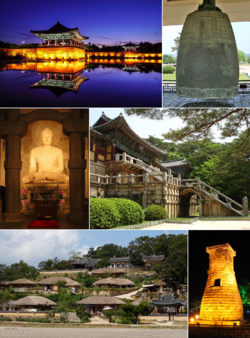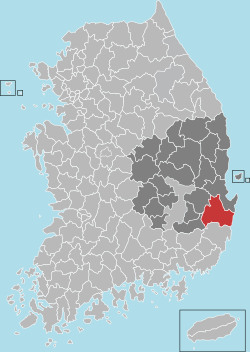Kyongju
|
Gyeongju 경주시 |
||
|---|---|---|
| Municipal City | ||
| Korean transcription(s) | ||
| • Hangul | 경주시 | |
| • Hanja | ||
| • Revised Romanization | Gyeongju-si | |
| • McCune-Reischauer | Kyŏngju-si | |

Top left: Anapji pond; Top right: Bell of King Seongdeok; middle left: Seokguram; middle right:Bulguksa temple; bottom left: Yangdong Folk Village; bottom right: Cheomseongdae.
|
||
|
||
 Location in South Korea |
||
| Coordinates: 35°51′N 129°13′E / 35.850°N 129.217°E | ||
| Country |
|
|
| Region | North Gyeongsang Province | |
| Administrative divisions | 4 eup, 8 myeon, 11 dong, 305 ri | |
| Area | ||
| • Total | 1,324.39 km2 (511.35 sq mi) | |
| Population (December 2012) | ||
| • Total | 264,091 | |
| • Density | 212/km2 (550/sq mi) | |
| • Dialect | Gyeongsang | |
| Website | City of Gyeongju | |
Gyeongju (Korean: 경주, pronounced [kjʌŋ.dʑu]), historically known as "Seorabeol" (Korean: 서라벌, pronounced [sʌ.ɾa.bʌl]), is a coastal city in the far southeastern corner of North Gyeongsang Province in South Korea. It is the second largest city by area in the province after Andong, covering 1,324 km2 (511 sq mi) with a population of 264,091 people (as of December 2012.) Gyeongju is 370 km (230 mi) southeast of Seoul, and 55 km (34 mi) east of Daegu. The city borders Cheongdo and Yeongcheon to the west, Ulsan to the south and Pohang to the north, while to the east lies the coast of the East Sea. Numerous low mountains—outliers of the Taebaek range—are scattered around the city.
Gyeongju was the capital of the ancient kingdom of Silla (57 BC – 935 AD) which ruled about two-thirds of the Korean Peninsula between the 7th and 9th centuries. Later Silla was a prosperous and wealthy country, and its metropolitan capital of Gyeongju was the fourth largest city in the world. A vast number of archaeological sites and cultural properties from this period remain in the city. Gyeongju is often referred to as "the museum without walls". Among such historical treasures, Seokguram grotto, Bulguksa temple, Gyeongju Historic Areas and Yangdong Folk Village are designated as World Heritage Sites by UNESCO. The many major historical sites have helped Gyeongju become one of the most popular tourist destinations in South Korea.
...
Wikipedia

